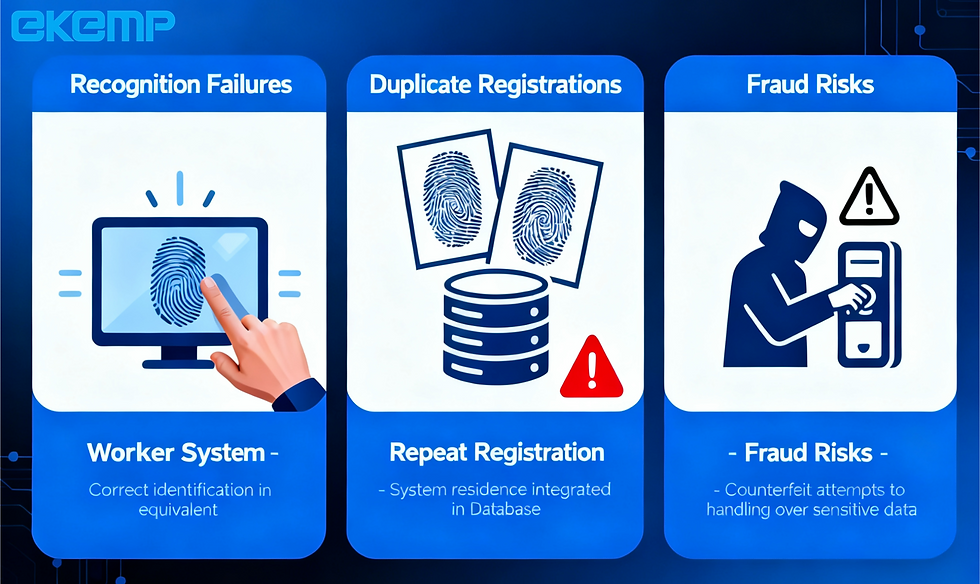The Rise of ePassports: A Secure Solution for Modern Travel
- Yoselin Huang

- Jul 22
- 3 min read
Updated: Sep 27
Understanding the Threat of Fake Passports
Criminals are constantly seeking loopholes to cross borders undetected. One of their most common tactics is using fake passports. This threat highlights a growing need for governments to adopt more secure travel documents—and that’s where ePassports come in.
Earlier this year (2025), the Delhi Police Crime Branch uncovered a passport forgery racket in Lucknow. The operation helped criminals flee abroad using forged documents.
Authorities seized:
6 fake passports
1,000 blank and pre-filled PVC identity cards (Aadhaar, PAN, Voter IDs)
Fake bank and government stamps
Laptops, mobile phones, and a PVC card printer
Case source: *The Hindu
This case raises an important question: Is there a better way to deal with fake passports, especially at border control?
The Limitations of Traditional Passports
Traditional passports contain printed personal information, such as name, photo, and nationality. They also include basic security features like:
Watermarks
Special inks
Holograms

While effective to a degree, these features lack embedded biometric technology. This makes traditional passports easier to duplicate using high-end printing equipment. As international threats grow more sophisticated, countries need more secure alternatives. That’s why ePassports are becoming a global trend.
What is an ePassport?
An Electronic Passport (ePassport)—also called a biometric passport—features a small NFC (Near Field Communication) chip embedded inside its cover.

This chip securely stores:
Personal data (name, birthdate, nationality)
Biometric data, such as digital photos, fingerprints, and facial recognition features
At airports, ePassport readers can scan this chip to verify the traveler’s identity quickly and accurately.

By 2025, 140 countries—nearly 72% of the world—will have adopted ePassports.
Comparing ePassports and Traditional Passports
Electronic Passport (ePassport)
Security: Contains an encrypted biometric chip
Data Stored: Fingerprints, digital photo, facial data
Verification Process: Autogate (eGate) access for quick clearance
Cover Appearance: Contains official ePassport logo
Forgery Risk: Extremely low due to chip encryption
Durability: Requires careful handling of the chip
Regular Passport
Security: No embedded chip
Data Stored: Basic personal info
Verification Process: Manual checks
Cover Appearance: No special marking
Forgery Risk: Higher
Durability: Standard booklet
The Advantages of ePassports
The rise of ePassports is not just a trend—it’s a strategic response to global mobility and security challenges. Here’s why countries are transitioning:
Faster Immigration Clearance: With autogate systems, travelers can clear immigration in seconds using biometric checks—no need to wait in long lines.
Minimized Fraud: ePassports reduce impersonation and passport fraud. The biometric data must match what’s scanned at the checkpoint.
Instant Detection: Border control agents can instantly detect mismatches or flagged individuals through integrated Automated Biometric Identification Systems (ABIS/AFIS).
Global Standards Compliance: The International Civil Aviation Organization (ICAO) sets global standards for ePassports. Countries adopting them gain greater travel privileges and visa exemptions.

EKEMP provides an ICAO standard photo camera in a biometric enrollment kit and a biometric tablet for identity registration. They are fast and secure with MOSIP compliance.
See more: *www.ekemp.com.cn
The Future of Travel Security
As identity fraud and global mobility risks increase, ePassports offer a future-ready solution. Their biometric layer, combined with encrypted data and international standards, makes them nearly impossible to forge—far superior to traditional paper-based documents. For travelers, they provide a faster, safer experience. For governments, they’re a powerful tool to protect borders and citizens.
At EKEMP, we are committed to empowering countries worldwide with secure, reliable identity solutions. From ePassport design and production to secure packaging and global delivery, our end-to-end services help governments build trusted digital identity systems. Together, we strive toward a safer, more connected world through advanced biometric technology.

Global Adoption of ePassports
Many developing countries are embracing ePassport solutions to improve national security and modernize travel infrastructure. For example, Indonesia now offers autogate access for ePassport holders. Several African nations are integrating AFIS portable fingerprint scanners with ePassport issuance for added security.
With these efforts, we are building a trustworthy, secure identity world together.
Ready to Learn More?
Interested in secure biometric identity solutions or ePassport technology?
Visit 👉 *www.ekemp.com.cn
Or contact 👉 *ekempchina@gmail.com






